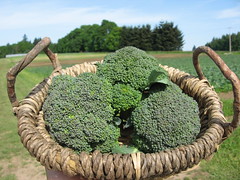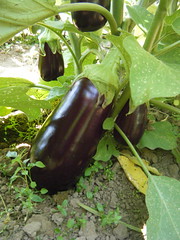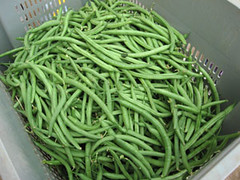
This Week’s Share
- Bok choi, Joi choi
- Carrots
- Escarole
- Garlic
- Onions, Copra
- Potatoes, yellow
- Romanesco
- Sweet Peppers
- Winter Squash, Acorn

On Rotation
Share Notes
- Broccoli: Fall broccoli is here. It started rotating through shares last week and will continue through this week. This season we have been experimenting with more fall Brassicas in the share. Enjoy its dense florets and more spicy flavor.
- Escarole: This week you will receive your first head of escarole. Escarole is a member of the chicory family, and is a more winter hearty green. It has a stronger and bolder flavor than the lettuce you have received throughout the season, and pairs nicely with dressings that are sweeter or saltier in flavor. Its also great lightly sautéed with some butter or bacon grease.
- Peppers: What a wonderful pepper season it’s been so far! Although sweet peppers are now winding down for the season, we can thank the new unheated greenhouse for this season’s bounty. Enjoy the last distributions as they make their way through the shares.
- Winter Squash: This week in your share you will receive 2 beautiful acorn squash. The acorn squash in particular has a sweet nutty flavor and relatively smooth texture. It is particularly good in soups and stews, as well as baked with butter and maple syrup.
Recipes
Escarole Recipes
Bold Winter Greens Salad
Adapted from Eating Well in Season by Jessie Price
2 cloves garlic, minced
1/4 teaspoon kosher salt
freshly ground pepper, to taste
1 tablespoon lemon juice
2 teaspoons sherry vinegar
2-3 anchovy fillets, rinsed and chopped
1/4 cup extra-virgin olive oil
6 cups chopped escarole
2 large hard-boiled eggs
Place garlic in a large salad bowl and sprinkle with salt and pepper. Add lemon juice and vinegar; let stand for 5 minutes. Stir in anchovies to taste. Whisk in oil in a slow steady stream until well combined. Add escarole and toss. Shred 2 eggs whites and 1 egg yolk. Sprinkle the salad with the grated egg.
Escarole and Rice Soup with Chicken
From Eating Well in Season by Jessie Price
1 tablespoon extra-virgin olive oil
1 small onion, chopped
1 head escarole, thinly sliced
7 cups reduced sodium chicken broth, divided
1/2 cup Arborio or other short-grain rice
12 ounces boneless, skinless chicken breasts, trimmed and cut into 1/2 inch cubes
1 14 ounce can whole tomatoes, drained, seeded and chopped
1/4 teaspoon salt
Freshly ground black pepper, to taste
2 tablespoons grated Asiago or Parmesan cheese
Heat oil in a Dutch oven over medium-high heat. Add onion and cook, stirring, until golden, 2 to 3 minutes. Add escarole and 1 cup of broth. Bring to a boil. Reduce heat to low, cover and simmer for 15 minutes. Stir in the remaining 6 cups of broth and bring to a simmer. Add rice and simmer, covered, for 10 minutes. Add chicken and tomatoes and cook, covered, until the rice is tender and the chicken is no longer pink inside, about 5 minutes longer. Season with salt and pepper. Ladle into a bowl and top with cheese.
Joi Choi Recipe
San Francisco Vegetable Soup
Adapted from http://recipeland.com
1/2 cup onions, sliced
1/2 cup carrots, thinly sliced
1 cup bok choi, thinly sliced
1/2 cup sweet red pepper, thinly sliced
2 teaspoon sesame oil
5-6 cups water
2 tablespoon vegetable bouillon powder
1/2 teaspoon ginger, ground
2 teaspoon granulated garlic
4 teaspoons garlic, minced fresh
1/4 cup snow pea pods (optional), diagonally sliced (could also use bean sprouts or pea shoots)
In a medium-size saucepan sauté onions, carrots, bok choi and bell pepper in oil over medium heat until vegetables soften, about 5 minutes. Add water, bouillon powder, ginger and garlic. Simmer until vegetables are tender, about 5 minutes. Add snow peas, cook for one minute and serve hot.
Potato Recipe
Lemon-Baked Potatoes
From the Territorial Seed Company Garden Cookbook
1/3 cup butter or margarine
3 tablespoons lemon juice
1 1/2 teaspoons garlic, minced
3/4 teaspoon dried dill weed
1/4 teaspoon grated lemon peel
1/8 teaspoon hot-pepper sauce
3 large or 6 medium potatoes
Preheat oven to 425˚F. In a small bowl combine butter or margarine, lemon juice, garlic, dill, lemon peel, and hot-pepper sauce. Mix well. Cut potatoes in half lengthwise. Make deep slits in cut surface every 1/4 inch, being careful not to cut through skin. Arrange in shallow baking pan. Brush with half the butter mixture. Bake 1 hour, brushing with remaining butter mixture every 15 minutes.
Winter Squash Recipe
Baked Acorn Squash with Herbed Stuffing
From the Rolling Prairie Cookbook by Nancy O’ Connor
Note: This recipe is easily doubled, just use two acorn squash and double the quantity of all other ingredients.
1 medium to large acorn squash
1 tablespoon olive oil
1 clove garlic, minced finely
1 medium onion, chopped
2 stalks celery, chopped
1 small apple, finely chopped
2-3 cups whole wheat bread cubes, cut in 1/2-inch cubes
1/2 cup vegetable broth
3/4 teaspoon salt
freshly ground black pepper
1 tablespoon finely chopped fresh sage leaves (or 1 teaspoon dried)
1 teaspoon finely minced fresh rosemary (or ¼ teaspoon dried)
1 sprig fresh thyme leaves, finely chopped (or ¼ teaspoon dried)
2 tablespoons fresh chopped parsley
1/4 cup chopped pecans or walnuts (optional)
Preheat oven to 350˚F. Cut each squash in half lengthwise. Scoop out the seeds. Place squash halved, cut side down, in a covered baking dish. Add several tablespoons of water to the dish, and bake until tender, approximately 40 minutes. Remove from oven and allow to cool slightly. Carefully scoop the pulp out into a small bowl, leaving about 1/4 inch of flesh in the shell. Place the empty shells cavity-side up in a clean baking dish. Set aside. Heat the olive oil in a large skillet over medium heat. Add the garlic, onion, celery, and apple. Sauté until just tender, approximately 10 minutes. If the vegetables begin to stick, add several tablespoons water to the pan. Add bread cubes and toss with vegetables. Pour vegetables broth over the mixture, stirring to evenly distribute. Add the cooked squash, breaking up any large chunks. Finally, stir in the salt, pepper, and fresh herbs (and nuts if your using them). Mix well. Remove stuffing from heat. Heap filling into the squash shells. Cover, and return to oven for another 20 minutes or until heated through. Each half can be cut in half lengthwise. Serves 4.

















